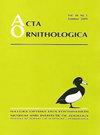Low Rate of Pre-Dispersal Acorn Predation by Eurasian Jays Garrulus glandarius during Non-Mast Years
IF 0.8
4区 生物学
Q3 ORNITHOLOGY
引用次数: 0
Abstract
Abstract. Mast-seeding is widely considered to be an adaptation that minimizes seed predation. The superabundance of seeds during mast years greatly exceeds the capacity of seed predators to consume them. These notions were based on research on food specialists such as insects and rodents. However, mast-seeding may have different impact on the behavior of corvids that are food generalists. The Eurasian Jay Garrulus glandarius is a widespread scatter-hoarding corvid that uses acorns as a food reserve for winter. In mast-years, the birds are supposed to be satiated by the greater seed supply and are able to store their surplus, acting as dispersal agents, whereas in poor crop seasons they use most of the crop for current consumption and thus become seed predators. In such a situation, a dispersal agent may become a seed predator, and vice versa. The main task of this study was to determine the levels of pre-dispersal acorn predation by Jays during non-mast years to verify the notion that under such conditions Jays act mostly as seed consumers. During two consecutive non-mast years, tagged acorns were radio-tracked and the acorns' fate (cached or eaten) was assessed. We found extremely low pre-dispersal acorn predation by Jays (0.9%). The possible reason is that temperatures in period of acorns collecting (September–October) are high enough to allow invertebrates to remain active, so the Jays may supplement their diet with insects and also fleshy fruits. Therefore, almost all acorns were cached and scatter-hoarding Jays provided effective seed dispersal, with extremely low consumption of acorns.欧亚Jays Garulus glandarius在非桅杆年份对橡子的低捕食率
摘要桅杆播种被广泛认为是一种能最大限度地减少种子捕食的适应方式。肥大年份种子的过剩大大超过了种子捕食者吃掉它们的能力。这些概念是基于对昆虫和啮齿动物等食物专家的研究。然而,桅杆播种可能会对作为食物多面手的corvid的行为产生不同的影响。欧亚Jay Garulus glandarius是一种广泛分布的分散囤积的corvid,它将橡子作为冬季的食物储备。在丰年,鸟类应该对更多的种子供应感到饱腹,并能够储存多余的种子,充当传播媒介,而在作物歉收的季节,它们将大部分作物用于当前消费,从而成为种子捕食者。在这种情况下,扩散剂可能会成为种子捕食者,反之亦然。这项研究的主要任务是确定Jays在非桅杆年份传播前对橡子的捕食水平,以验证在这种情况下Jays主要充当种子消费者的观点。在连续两年的无桅杆期间,对带标签的橡子进行无线电跟踪,并评估橡子的命运(缓存或食用)。我们发现Jays在传播前对橡子的捕食率极低(0.9%)。可能的原因是橡子采集期(9月至10月)的温度足够高,可以让无脊椎动物保持活跃,因此Jays可以用昆虫和肉质水果来补充饮食。因此,几乎所有的橡子都被缓存起来,而囤积橡子的Jays提供了有效的种子传播,橡子的消耗量极低。
本文章由计算机程序翻译,如有差异,请以英文原文为准。
求助全文
约1分钟内获得全文
求助全文
来源期刊

Acta Ornithologica
生物-鸟类学
CiteScore
2.10
自引率
0.00%
发文量
14
审稿时长
>12 weeks
期刊介绍:
Publishes scientific papers (original research reports, reviews, short notes, etc.) and announcements from all fields of ornithology. All manuscripts are peer-reviewed.
Established in 1933 as Acta Ornithologica Musei Zoologici Polonici, since 1953 continued under the present title.
Published twice a year by the Natura Optima Dux Foundation under the auspices of the Museum and Institute of Zoology, Polish Academy of Sciences.
 求助内容:
求助内容: 应助结果提醒方式:
应助结果提醒方式:


